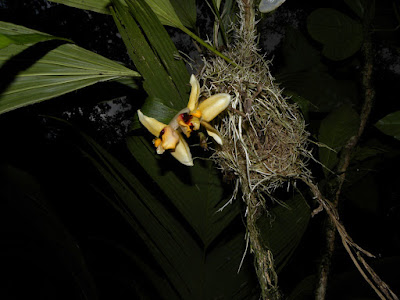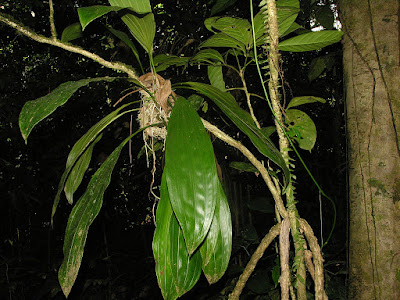Stanhopea cirrhata - Tendril Stanhopea flowers are small for the genus, showy, white yellowish, without horns, with Vicks vapo rub scent; lip orange..
Stanhopea cirrhata called as Tendril Stanhopea, Stanhopeastrum cirrhatum, is a species of the genus Stanhopea. This species was described by John Lindley in 1850.
DESCRIPTION OF STANHOPEA CIRRHATA - TENDRILL STANHOPEA
Stanhopea cirrhata is native to Central America. This orchid is found growing on trees overhanging slow moving rivers, streams and rills in deciduous forests of seasonally dry lowlands of Costa Rica, Honduras, Nicaragua, Panamá at elevations of 100-800 meters above sea level.
It is a medium sized, hot growing epiphyte with a ovate pseudobulbs of up to 6 cm long. The apical leaf having 7 nerves, 60 cm long, including the 1.5 cm long petiole, coriaceous, ribbed, gradually narrowing below into the elongate, channeled petiolate base.
Tendril Stanhopea blooms in the fall from the lateral inflorescence, with a pendant raceme generally having 2 flowers and a peduncle with several inflated dictic sheaths that arise on a mature pseudobulb. The flowers are small for the genus, showy, white yellowish, without horns, with Vicks vapo rub scent; the base of the lip is orange.
STANHOPEA CIRRHATA - TENDRILL STANHOPEA CARE
Cultural information should only be used as a guide, and should be to be adapted to suit you. Your physical location; where you grow your plants, how much time you have to devote to their care, and many other factors, will need to be taken into account. Only then can you decide on the cultural methods that best suit you and your plants.
Light:
Stanhopea cirrhata needs a light level of 25000-35000 lux. The light should be filtered and dispersed, and the plants should not be exposed directly to the sun in the afternoon hours. The plants may reluctant to flower with insufficient light, but with too much light, the leaves tend to burn and yellowing. Strong air movement should be ensured all the time.
Temperature:
The average summer temperature is 23-29 °C during the day and 14-18 °C at night, which gives a daily difference of 8-11 °C. The average winter temperature is 23-24 °C at day, 12-14 °C at night, with a daily amplitude of 9-11 °C.
Humidity:
Tendril Stanhopea needs the humidity of around 70-80% for most of the year. Too dry air has a negative effect on the development of the plant: its growth is inhibited, and the leaves begin to turn yellow and dry out. The higher temperature, the higher the humidity should be, and the higher the humidity, the more often and longer it is necessary to ventilate the room where the plants are contained, otherwise the probability of rotting and various kinds of fungal diseases. Good air movement is essential while the plants are in leaf and growing.
Substrate, growing media and repotting:
Stanhopea cirrhata are usually grown on rootstocks or in hanging baskets, because it is necessary in the case of hanging inflorescences that appear at the base of the pseudobulb and grow directly down. It seems that plants grow best and it is most convenient to grow them if they are attached to tree ferns. Fixed plants, however, require high humidity and at least daily watering in the summer, and it may even be necessary to water several times a day if the weather is dry and very hot.
These plants are also grown in wire baskets with large mesh moss-covered with sphagnum moss and filled with loose, quickly drying ground. The substrate should remain moist, but it can not be wet, because the roots must dry relatively quickly after watering.
Repotting or dividing should be done when the growth of new roots begins. This allows the plants to acclimatize in a relatively short time and provides them with the least stress.
Watering:
Tendril Stanhopea should be irrigated abundantly during active growth, but their roots must dry quickly after watering, and the ground around them must never be spread or soggy. When new growths reach maturity and flowering has finished, the amount of water should be drastically reduced.
Fertilizer:
During the active growth, Stanhopea cirrhata should be fertilized every week 1/4-1/2 of the recommended dose of fertilizer for orchids. You can use balanced fertilizer throughout the year, but you can also use fertilizer with increased nitrogen content from spring to mid summer, and then in the late summer and autumn, use a fertilizer with a higher content of phosphorus.
Rest period:
In winter, watering should be limited, but must not be allowed to stay dry for a long time. Occasional fogging between uncommon watering should satisfy the requirements of these plants during the drought season. For about a month in winter, watering should be limited only to sporadic fogging, which will prevent excessive drying of the plant. Fertilization should be reduced or eliminated until new growths appear in the spring and more abundant watering starts.















COMMENTS